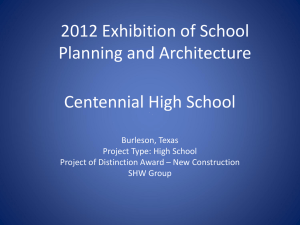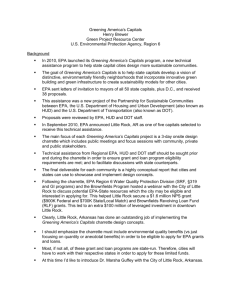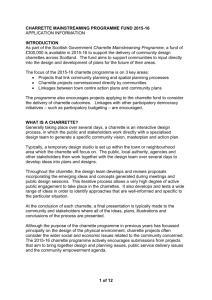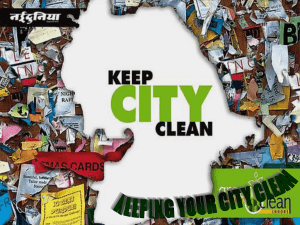here - Scottish Community Development Centre
advertisement
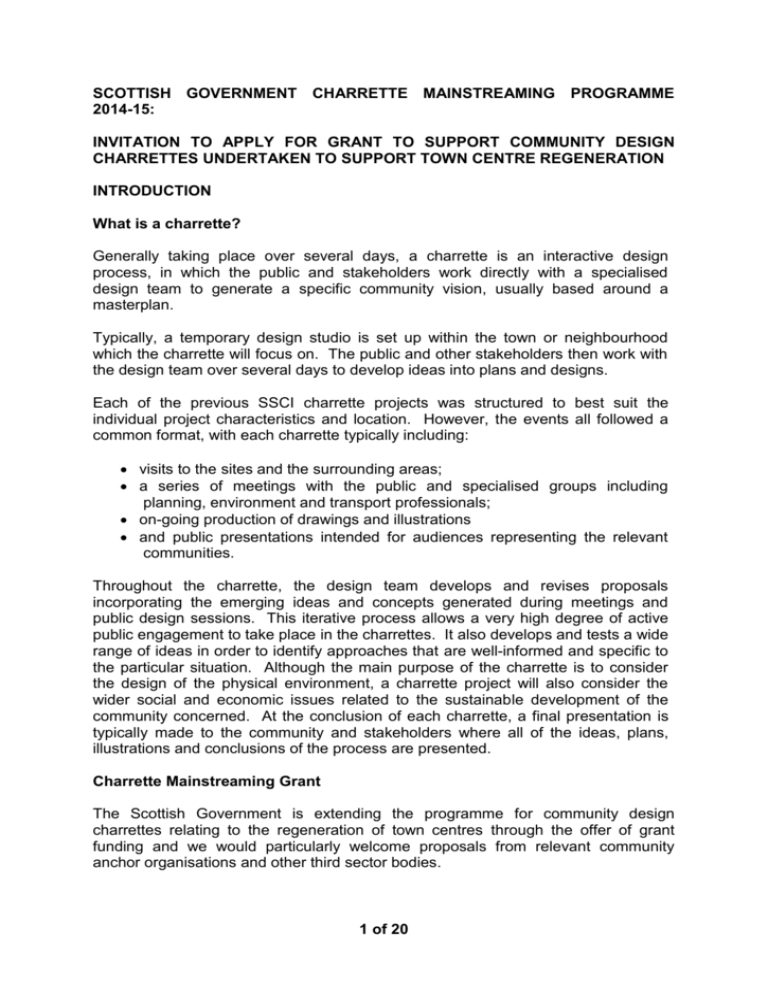
SCOTTISH GOVERNMENT CHARRETTE MAINSTREAMING 2014-15: PROGRAMME INVITATION TO APPLY FOR GRANT TO SUPPORT COMMUNITY DESIGN CHARRETTES UNDERTAKEN TO SUPPORT TOWN CENTRE REGENERATION INTRODUCTION What is a charrette? Generally taking place over several days, a charrette is an interactive design process, in which the public and stakeholders work directly with a specialised design team to generate a specific community vision, usually based around a masterplan. Typically, a temporary design studio is set up within the town or neighbourhood which the charrette will focus on. The public and other stakeholders then work with the design team over several days to develop ideas into plans and designs. Each of the previous SSCI charrette projects was structured to best suit the individual project characteristics and location. However, the events all followed a common format, with each charrette typically including: visits to the sites and the surrounding areas; a series of meetings with the public and specialised groups including planning, environment and transport professionals; on-going production of drawings and illustrations and public presentations intended for audiences representing the relevant communities. Throughout the charrette, the design team develops and revises proposals incorporating the emerging ideas and concepts generated during meetings and public design sessions. This iterative process allows a very high degree of active public engagement to take place in the charrettes. It also develops and tests a wide range of ideas in order to identify approaches that are well-informed and specific to the particular situation. Although the main purpose of the charrette is to consider the design of the physical environment, a charrette project will also consider the wider social and economic issues related to the sustainable development of the community concerned. At the conclusion of each charrette, a final presentation is typically made to the community and stakeholders where all of the ideas, plans, illustrations and conclusions of the process are presented. Charrette Mainstreaming Grant The Scottish Government is extending the programme for community design charrettes relating to the regeneration of town centres through the offer of grant funding and we would particularly welcome proposals from relevant community anchor organisations and other third sector bodies. 1 of 20 This programme of charrettes will run in parallel with the programme of Local Development Plan charrettes already announced. Both programmes are part of the Scottish Government’s SSCI Charrette Mainstreaming Programme. The town centre charrette programme also supports and is an integral part of the Scottish Government’s 2-year Town Centre Demonstration Phase testing of the ideas of the National Review of Town Centres and subsequent Scottish Government actions in support of the Town Centre Action Plan. Further details of the ‘Town Centre Demonstration Phase’ programme are attached in Annex A. Information about the Town Centre charrettes undertaken in 2013-14 is provided at Annex B, items 16-20. This document invites submissions from project proposers wishing to apply for grant from the Scottish Government towards the cost of a town centre regeneration design charrette. Grants will be available for charrettes that contribute towards the creation of visions or masterplans for the regeneration of town centres. Applications from local authorities should, take account of the cross-public sector commitment to the Town Centre First Principle proposed by the National Review of Town Centres, and of the potential links between spatial planning and community planning. Details of the invitation and eligibility are provided below. Further background on the use of charrettes and the SSCI Charrette Mainstreaming programme is also provided at Annex A. The maximum grant awarded will be for 50% of the cost of a charrette project. The maximum grant awarded to any one project is expected to be in the order of £15,000-£20,000. Grant awarded will be exclusive of any requirement to pay VAT which will be the responsibility of the project sponsor. The closing date for receipt of proposals for the first round of grant awards is 21 August 2014. Proposals should include a completed version of the summary form attached as Annex D. We would also encourage the use of Annex D to make an initial submission, to start discussions with the Scottish Government, before a full submission is developed with a final version of the summary form. A initial submission may also contain any other appropriate brief documentation which helps support the proposal. For community and third sector applicants this may include information about the organisation and it’s work, evidence of community consultation, etc. If this is the chosen route, Annex D should be submitted as soon as possible, as the full proposal will be required to be received by 21 August. Total funding available is £120,000. Invitations for applications for a second round of awards of grant may be made if funding is still available after selection of projects from the first round of proposals. INVITATION This document invites local authorities, community and third sector organisations, and anyone involved with the design, planning or delivery of town centre renewal to submit concise proposals for grant to assist in the cost of a suitable charrette project. Proposals should be in-line with the criteria set out below. Projects submitted should illustrate how charrette working will support the creation of a framework or masterplan for creating a vision for retaining, repairing, renewing 2 of 20 and developing existing town centres in a sustainable manner and in accordance with the aspirations of the National Review of Town Centres and the Scottish Government’s response, the Town Centre Action Plan. Town centre charrette projects should address those key themes of the Town Centre Action Plan relevant to the particular town centre and deliver outputs which, where relevant, support and fit with these themes: Engagement with the private sector Town Centre Living Vibrant Local Economies Enterprising Communities Accessible Public Services Digital Towns Proactive Planning. The Town Centre First Principle Town centres are a key element of the economic, social and environmental fabric of Scotland’s towns. They are often at the core of community and economic life: offering spaces to live, meet and interact, do business, and access facilities and services. We must take collective responsibility to help town centres thrive sustainably, reinvent their function, and meet the needs of residents, businesses, and visitors for the 21st century. A Town Centre First Principle has been developed and agreed. It requests that:Government, local authorities, the wider public sector, businesses and communities put the health of town centres at the heart of proportionate and best value decision making. Seeking to deliver the best local outcomes regarding investment and deinvestment decisions, alignment of policies, targeting of available resources to priority town centre sites, and encouraging vibrancy, equality and diversity. The outcome is a commitment to a collaborative approach which understands and underpins the long term plan for each town centre. Because they bring people together in a collaborative process, charrettes are a good vehicle for carrying out the objectives of the Town Centre First Principle. Town centre charrettes may be undertaken at the beginning or any suitable later stage of a regeneration project, but proposers should be able to produce a strong case for how they expect the regeneration of the town centre to benefit from utilising charrette-style working. Proposers should also show how it is intended that the charrette outcomes will be sustained and progressed following the conclusion of the charrette. We are particularly interested in proposals that find new ways to use charrettes in the context of town centre regeneration. Grant awarded will be solely for use towards the costs of the professional services provided by a design team and their project-related expenses. The project proposer will be responsible for selecting and appointing a specialist design team to devise 3 of 20 and deliver the charrette. The procurement process for a design team should be conducted within the normal practice and processes of the project proposer. Scottish Government procurement rules will not apply, but the project proposer should be able to demonstrate that the process delivers best value for money and quality of service. Advice on the process of selection of a suitable design team and development of the pre-charrette and charrette programme of events is attached as Annex C. The Scottish Government should be kept informed of progress in these processes. Further advice and support for individual projects will also be available. Project proposers will be required to provide all necessary base information for the charrette and make all necessary preparatory arrangements: the cost of providing these will not be grant-fundable. The exact requirements of individual charrettes will vary and details will be required to be agreed between the design teams, project teams and the Scottish Government in advance of award of grant. Project proposals should demonstrate clearly why charrette working is appropriate to their project and the particular stage that the charrette will take place at in the development of a regeneration project. An objective of the charrette mainstreaming programme is to explore the variety of ways in which charrettes can be effective in Scottish practice and what forms might be employed for projects at differing stages. Charrettes awarded grant may vary considerably in duration and may follow a range of different formats. They will, however, be required to provide the range of benefits relating to Vision, Engagement and Outputs described below. It is a requirement of grant funding that charrettes are intensive, iterative multi-day events: involving cycles of plan development, presentation, and refinement; and are design-led with predominantly graphic outputs. They should normally consist of a series of events taking place over a single series of consecutive days. There may be circumstances where there are good reasons to break the project into 2 parts to allow the design team to progress design proposals, but this should be discussed and agreed with the Scottish Government before being incorporated into the charrette programme. Proposal Content Proposals should support the objectives of the Scottish Government for sustainable development. Promoters are requested to outline the proposal in a short and focussed written document of not more than 6-8 pages based on the following 4 themes. 1. Project - Vision and Aims Proposals should demonstrate how they contribute to a vision for high quality sustainable development, providing detail in a clear and accessible format on the issues listed below. Relevant plans and drawings may be provided to illustrate these issues. 4 of 20 The nature of the proposal, including the current stage in the process of regeneration of the town centre and at what point in the process is it proposed that the charrette will take place. The location and scope of the town regeneration project. Key issues that the charrette will be expected to deal with: masterplanning, landscape issues, flooding, transport etc. How the proposal is aligned with the aims of the Scottish Government’s Town Centre Action Plan, the Town Centre Review – Community and Enterprise in Scotland’s Town Centres, SSCI and the Scottish Government’s policies, in particular, Creating Places, Designing Places, Designing Streets and Achieving a Sustainable Future. An outline of any wider benefits to the community covering potential economic, health, environmental and social issues. Any other relevant issues. 2. Process and Engagement Proposals should demonstrate the buy-in of key stakeholders or a strategy for encouraging participation of such groups in the charrette. Proposals that are made in collaboration between a number of interested parties, especially local community groups, are particularly encouraged. Proposals that could lead to initiatives that generate income for a community are also especially welcome. Flexibility and ability to work collaboratively with others in a multi-disciplinary team structure is encouraged. Proposals are expected to include: 3. A indicative programme, providing details on the expected timing and duration of the charrette and delivery of the charrette outputs A brief explanation of key personnel who will act as client for the project and their relationship to the structure of the organisation(s) commissioning the charrette An indicative list of groups or individuals who are, or are likely to be involved in the charrette process Details on the procurement process being used to select and appoint the charrette consultant design team, including proposed timescales for the appointment process Details of how the local authority expects to provide practical assistance in the organisation of the charrette. This may include details on venues, publicity and council officer input. Suitability, Outputs and Implementation The interrogative, design-led approach of charrette working can assist many types of project at a variety of stages. A main aim of the charrette mainstreaming programme is to promote the use of this methodology through projects that will benefit the most. Proposals should therefore be able to demonstrate the suitability of charrette working 5 of 20 within their general approach to the regeneration of the town centre and a commitment to a design-led approach within the wider process. It is important that the charrette provides the opportunity to improve the development and quality of the overall regeneration process and is not viewed simply as a consultation process. How charrette outputs are taken forward after the charrette to influence the quality of the wider regeneration project is of critical importance. Proposals are expected to include: A short statement on how charrette working is expected to benefit the regeneration of the town centre Information on how the outputs of the charrette will be taken forward after the charrette event programme is completed. Submissions Proposals should be submitted in an electronic format by email. Hard copies are not required. Proposals should not be more than 6-8 pages at A4 format. In addition, a 2-page summary document (as Annex D to this invitation), should be completed and attached to the proposal. Proposals should be submitted on or before 21 August to the address below. A summary using the template at Annex D may be submitted at any time before them. Jim Mitchell Architecture and Place Planning and Architecture Division The Scottish Government Area 2-J South Victoria Quay Edinburgh EH6 6QQ T: 0131 244 7476 E: Jim.mitchell@scotland.gsi.gov.uk Once the full proposal has been submitted, no further information will be accepted unless requested by the Scottish Government. Assessment Assessment of submissions will be based on the issues contained in the Proposal Content section above. It may include further discussion with local authorities, proposers or stakeholders. It is expected that the results of the assessment process will be made available to proposers within 4 weeks of 21 August. Grant will be made available on a competitive basis to projects assessed as most fully meeting the requirements of this invitation. 6 of 20 Conditions for the award of grant to successful proposals Projects judged to address the above issues well and which have the ability to assist the mainstreaming of charrette style working throughout Scotland will be eligible for a grant towards the cost of the project. The maximum grant awarded will be for 50% of the cost of the professional services required for the project. Grant cannot be paid to cover any VAT applicable to the project. The maximum grant awarded to any one project is expected to be in the order of £15,000-£20,000. There will be no subsequent increase in the size of the grant awarded. Grant will only be awarded where the proposed is in line with the objectives of the National Review of Town Centres. The Scottish Government’s standard conditions for the offer of grant will apply. Grant funding will be conditional until appropriate details of the charrette programme and the procurement process are provided along with confirmation of completion of the process of appointment of the design team. After discussion with the project sponsor, an end date for the provision of this information will be set for each project, after which funding will be withdrawn if sufficient information has not been provided. Grant will be paid immediately after the completion of a charrette project and acceptance of any final charrette report required by the project sponsor. All agreed deliverables and conditions for the award of grant will be required to be met before grant is paid. Scottish Government officials may require to be involved as observers at projects awarded grant funding. Post-Charrette Involvement It is expected that following the conclusion of the charrette, project teams will support the promotion of the process and lessons learned. This may involve providing feedback into a charrette summary document which will help to inform charrette working in Scotland and the publication of the outputs of the charrette in the charrette summary document. Sensitive or commercially confidential information will not be published. Projects selected for grant assistance will be supported throughout the charrette process by the Scottish Government. However, they will not be designated as SSCI exemplar projects. Formal support for the project will be limited to the charrette process and it is not anticipated that the Scottish Government will remain involved after the charrette has been completed and the obligations of grant fulfilled. However, the Scottish Government may wish to maintain some contact with the projects following conclusion of the charrette. Further Information For further information on the grant process and the charrette mainstreaming programme please contact Jim Mitchell or Sandy Robinson at the address provided on page 6 above. 7 of 20 ANNEX A SUPPLEMENTARY INFORMATION The ‘Town Centre Demonstration Phase’ programme The Objectives of the demonstration phase programme are: To establish a project framework for resourcing and effective co-ordination of the individual demonstration projects which test key recommendations and actions set out in the National Review of Town Centres and the Town Centre Action Plan To link with and build upon, the positive reception and reputation of the Town Centre Review process To engage partnerships, communities of practice and local town centre communities in this work To promote the work as it gets underway and identify further opportunities for additionality To capture and share learning from these demonstration projects To set this within the wider context of the Scottish Government’s commitment to fostering innovation and creativity, both internally and externally And to promote an asset-based approach to regeneration activity. The benefits expected of the demonstration phase programme are: Testing and trying out further ideas to provide solutions for town centre revitalisation at local level Ensuring read across between demonstration pilots and wider action research work Providing Government support to local authorities and other external partners to enable them to tackle town centre regeneration effectively Pooling wider public sector resources Supporting local innovation and service improvement. Background to the SSCI Charrette Mainstreaming Programme The Scottish Sustainable Communities Initiative (SSCI) was launched in June 2008 to identify and encourage the creation of new sustainable communities in Scotland. As part of the initiative, the Scottish Government has supported a number of collaborative design workshops, known as charrettes, in a variety of locations across Scotland. The initiative has demonstrated the value of charrettes in harnessing the knowledge and expertise within communities, increasing the speed and efficiency of plan making, and embedding design at an early stage to improve the quality of outcomes. Further details of these charrette projects are provided at Annex B. 8 of 20 ANNEX A Why use a charrette? Charrette style working is an innovative and effective way of delivering quality and efficiency. It can provide a range of benefits that are central to planning sustainable communities: Vision A crucial part of the charrette approach is that throughout the process, all contributors, regardless of their particular interest, have the opportunity to contribute towards the ultimate objective: the creation of a vibrant and successful communities. This collaborative approach pulls together disciplines and practices that are all too often focused on individual issues and allowed them to maximise their effectiveness by channelling all participants towards an over-arching vision. Engagement An inspirational and energising process, charrette working allows anyone to contribute to an evolving process, harnessing vital local knowledge and empowering communities to shape their future environments. Supported by specialist designers, local contributors are able to assist in the production of proposals that reach beyond what might normally have been achievable through traditional development processes. The continual presentation and testing of ideas allows a layering of understanding and knowledge to be established, refining the proposals in a concentrated timeframe so that potential conflicts are identified and positive design opportunities are maximised. Speed and Outputs One of the principal benefits of the charrette approach is its ability to blend contributions from a wide range of interest all into a meaningful form: plans, visualisations and sketches that are easily understood and form a consistent vision. This is achieved by the design-led and highly visual approach that effective charrette working requires. Charrette working not only provides benefits in terms of input and quality, but it also has the potential to greatly increase the speed of the planning and design process. It front-loads input and it involves a concentrated period of working when contributions have the ability to make a positive impact and shape emerging proposals. Despite the intense nature of the charrette itself, the approach can be much more efficient than a conventional model on account of the time saved later in the process, when analysis is often more reactive and can have less positive influence. Charrettes and Town Centres The Scottish Government wants to see strategic visions for town centre renewal that maximise the opportunities for our communities to flourish, support local economic development and that preserve and enhance our built heritage and natural environment. To achieve this involves rigorous analysis and a creative response to developing proposals. Charrettes provide an opportunity to involve a wide range of people and organisations, increase efficiency and improve the quality of the plan9 of 20 ANNEX A making process and outputs. Recent charrettes have demonstrated the value of involving design in early stages of development planning process to scope and develop options, to discuss and resolve issues and, ultimately, to pull information and evidence together into a deliverable masterplan. References Details on the Scottish Sustainable Communities Initiative can be found at: http://www.scotland.gov.uk/Topics/Built-Environment/AandP/Projects/SSCI The following Scottish Government policies can be found at: National Review of Town Centres, Community and Enterprise in Scotland’s Town Centres http://www.scotland.gov.uk/Resource/0042/00426972.pdf The Town Centre Action Plan: http://www.scotland.gov.uk/Resource/0043/00437686.pdf Regeneration Strategy: Achieving a Sustainable Future http://www.scotland.gov.uk/Resource/Doc/364595/0123891.pdf Creating Places: A policy statement on architecture and place for Scotland: http://www.scotland.gov.uk/Publications/2013/06/9811. Designing Places: http://www.scotland.gov.uk/Topics/Built-Environment/planning/National-PlanningPolicy/Designing Designing Streets: http://www.scotland.gov.uk/Publications/2010/03/22120652/0 Scottish Planning Policy: http://www.scotland.gov.uk/Topics/Built-Environment/planning/National-PlanningPolicy/newSPP 10 of 20 ANNEX B SSCI CHARRETTE PROJECTS CARRIED OUT: 2010-14 A report on the three initial SSCI Charrettes, (outlined below), can be found at: http://www.scotland.gov.uk/Topics/BuiltEnvironment/AandP/Projects/SSCI/SSCICharretteSeries/Charrette 1. Grandhome, Aberdeen Carried out in March 2010, this charrette undertook collaborative masterplanning of a major new urban extension to Aberdeen in support of one of the projects selected as an SSCI exemplar. It was carried out under the leadership of the American charrette expert Andrés Duany for the Grandhome Trust and was funded in part by grant from Scottish Government through the SSCI. 2. Lochgelly, Fife Carried out in March 2010, this project undertook collaborative masterplanning of the expansion of Lochgelly under a Strategic Land Allocation and regeneration of the town centre in support of one of the projects selected as an SSCI exemplar. It was carried out under the leadership of the American charrette expert Andrés Duany for Fife Council and was funded in part by the Scottish Government through the SSCI. 3. Ladyfield, Dumfries Carried out in March 2010, this project undertook collaborative masterplanning of a major new development on the edge of Dumfries in support of one of the projects selected as an SSCI exemplar. It was carried out under the leadership of the American charrette expert Andrés Duany for the Crichton Trust and Development Company and was funded in part by the Scottish Government through the SSCI. Reports of the six SSCI Mainstreaming Charrette projects carried out in 2011-12 and 2012-13 (outlined below), can be found at: http://www.scotland.gov.uk/Topics/BuiltEnvironment/AandP/Projects/SSCI/Mainstreaming The design team for these six charrettes were appointed by competitive tender. 4. Johnstone South West Carried out in November 2011, this project considered the development of a shared vision and masterplan for the regeneration of the existing urban neighbourhood which forms one third of Johnstone. It was carried out by a design team led by the Glasgow office of Austin-Smith: Lord for Renfrewshire Council and was funded by the Scottish Government through a framework contract under the Charrette Mainstreaming Programme. 5. Callander Carried out in November 2011, this project considered the development of a shared vision and masterplan for the future of Callander. It was carried out by a design 11 of 20 ANNEX B team led by BRE Scotland and 7N Architects of Edinburgh for the Callander Partnership and was funded by the Scottish Government through a framework contract under the Charrette Mainstreaming Programme. 6. Girvan Carried out in March 2012, this project considered the development of a shared vision and masterplan for the future of Girvan, linking the public spaces around a new multi-functional building (replacing the former swimming pool) with the beachfront, harbour side and retail area. It was carried out by a design team led by John Thompson & Partners of Edinburgh and London, for South Ayrshire Council and was funded by the Scottish Government through a framework contract under the Charrette Mainstreaming Programme. 7. Wick and Thurso Carried out in February 2013, this project consisted of two related ‘whole town’ charrettes in Thurso and Wick to create a shared vision for the future of the towns and assist the process of developing the Caithness & Sutherland Local Development Plan. The project was carried out by a design team led by John Thompson & Partners of Edinburgh and London, for The Highland Council and was funded by the Scottish Government through a framework contract under the Charrette Mainstreaming Programme. 8. Loch Lomond & The Trossachs National Park Authority Carried out in March and April 2013, this project assisted the development of the Local Development Plan for the Park by focusing on developing a shared vision for the future of the communities at Aberfoyle, Drymen/Balmaha, Tyndrum and Arrochar/Succoth/Tarbert. The project focused particularly on tourism and took a wider strategic view of the role of these communities in the future development of tourism in the Park. The project was carried out by a design team led by BRE Scotland and 7N Architects of Edinburgh for Loch Lomond and the Trossachs National Park. It was funded by the Scottish Government through a framework contract under the Charrette Mainstreaming Programme. 9. South Wishaw Carried out in March 2013, this ‘mini-charrette’ focused on reviewing effective housing land supply issues and developing a spatial strategy for housing development in the South Wishaw area as part of the development of the North Lanarkshire Local Development Plan. This charrette was on a smaller scale than the other projects in the series and was specifically targeted at a client group of developers, landowners, community representatives, external stakeholders and Council officials. The project was carried out by a design team led by the Glasgow office of Austin-Smith: Lord for North Lanarkshire Council and was funded by the Scottish Government through a framework contract under the Charrette Mainstreaming Programme. 12 of 20 ANNEX B The six LDP charrettes carried out under the Charrette Mainstreaming Programme in 2013-14 were 50% grant aided by the Scottish Government and are outlined below: 10. Blairmore Village Green, (near Dunoon), Argyll and Bute This project was led by The Loch Lomond and The Trossachs National Park in association with Blairmore Village Trust and converted a one-day consultation and visioning event into a two-day mini-charrette. As a result of the ideas developed at the charrette event in January, a further event was held in March to focus on tourism aspects of the project. The grant awarded by the Scottish Government boosted the effectiveness of the project by converting it from a limited consultation exercise to a design charrette, delivering outputs to feed into the proposed LDP. 11. North Lanarkshire Council (NLC): Business and Industry charrette A Council-wide charrette to develop a series of options for inclusion in the Main Issues Report (MIR) for the LDP, outlining hierarchies or spatial frameworks of places for industry and business. The charrette identified locational sensitive issues and the mix of uses/services which make a successful place, and proposed actionplanned interventions to deliver sustained economic growth across North Lanarkshire. 12. Kirkcaldy Victoria Road Regeneration Area Led by Fife Council, this charrette was concerned with creating a land use and development strategy for the redevelopment for mixed uses of a major brownfield regeneration site near the centre of Kirkcaldy. There are complex social, environmental and economic issues relating to the site most effectively resolved by using a charrette to create the development strategy proposed by the MIR to be included in the LDP. 13. Port Dundas, Glasgow A charrette for the creation of a masterplan for the regeneration of the highly visible and central brownfield site centered on the former Diageo distillery at Port Dundas on the Forth and Clyde Canal. The charrette was developed by Glasgow City Council jointly with Scottish Canals and explored possible new uses for the site, taking account of possibilities for improving connections to adjoining areas and integration with the adjacent cultural and adventure sport use. The charrette considered strategic infrastructural requirements and design parameters for the development of new buildings and spaces, and integration of committed proposals with future development aspirations. The key outputs are a Masterplan and implementation plan for the site to form Supplementary Guidance to the proposed LDP. 14. Muirtown and South Kessock, Inverness This charrette, developed by The Highland Council jointly with Scottish Canals, supports the creation of a masterplan for the regeneration of Muirtown Basin and the 13 of 20 ANNEX B adjacent area of South Kessock at the entrance to the Caledonian Canal to the west of the centre of Inverness. There are a complex set of physical and social issues relevant to this area and the development of a masterplan will be invaluable to economic and physical regeneration of the area. The masterplan created by the charrette will form Supplementary Planning Guidance to the Inner Moray Firth LDP. 15. Bowling Canal Basin, West Dunbartonshire This charrette was for the creation of a masterplan of the Bowling Basin area where the Forth and Clyde Canal joins the Clyde estuary. The site is a key waterfront regeneration priority and was developed by West Dunbartonshire Council jointly with Scottish Canals. The charrette produced a masterplan for the site which is a requirement of the proposed LDP to guide the comprehensive development of the site. The masterplan is supported by design-guidance to ensure that the ambition for placemaking and design quality are carried through in the individual phases of development. The five Town Centre charrettes carried out under the Charrette Mainstreaming Programme in 2013-14 were 50% grant aided by the Scottish Government and are outlined below: 16. Neilston Town Centre, East Renfrewshire This project was led by Neilston Development Trust with East Renfrewshire Council and built on the 2009 consultation process, the Renaissance Town project, which led to the Neilston Town Charter. The charrette produced a design framework and planning guidelines, along with consideration of options and opportunities presented by the proposed greenfield housing release, and the creation of an implementation plan. The project built on significant Council and community work on the regeneration of Neilston in recent years. 17. Port Glasgow Town Centre This 4 day charrette was led by Riverside Inverclyde URC with Inverclyde Council and addressed the strategic economic vision for the town centre. It was carried out as part of the development strategy leading to a masterplan as part of the town centre regeneration strategy for Port Glasgow. The charrette was concerned with raising the ambitions and aspirations of the community and developing an economic and spatial urban design strategy, addressing the masterplanning of future development, addressing the key issues of vacant and derelict sites and underutilised buildings and aligning regeneration with sustainable growth targets. Placemaking was an important theme of the charrette which aimed to address issues raised by inappropriate modern interventions in the Victorian town which undermine place quality. This was the first mainstreaming charrette proposal involving an urban regeneration company. 14 of 20 ANNEX B 18. Bridgend Town Centre, Perth and Kinross This charrette for the town of Bridgend on the A93 was led by Perth and Kinross Council with the Left Bank Community Development Trust and Bridgend, Gannochy and Kinnoull Community Council. The charrette was intended to act as a catalyst to progress the improvement plan for Bridgend set out in the Community Plan 2012-17 and bring together the community and other stakeholders to create a shared vision for Bridgend for the next 15 years. The charrette considered key issues raised by the impact of road traffic and the run-down appearance of Bridgend as a gateway to Perth. These include flooding, air quality, parking, gap sites, empty buildings and the need for community facilities. The objectives of the project was to set out ideas which could lead to regeneration of the riverbank and proposals for streetscaping which can encourage town centre living, business investment and the creation of a vibrant economy, partly by engaging with the private sector and levering–in private sector investment. The outputs from the charrette will be taken forward and funded partly through the Empty Homes Initiative and Vacant Property Feasibility Funding. It is expected that the Community Development Trust will approach HLF and others for funding. The Council may also consider a Conservation Area Regeneration Scheme to take forward some of the outcomes from the charrette. 19. Public Realm Regeneration: South Queensferry This charrette was led by Queensferry Ambition with Almond Neighbourhood Partnership to explore the potential to improve the public realm in the area of South Queensferry between the two bridges (including the waterfront) and to address issues facing the town centre adjacent to the existing streetscape on the High Street. The site lies within the Queensferry Conservation Area and adjoins a Local Conservation Site and the Firth of Forth Special Protection Area. Redevelopment of the area would support a number of development plan aims, including tourism, built environment and support for town centres allied to the work of the Business Improvement District. The charrette engaged with local residents and community groups, businesses and other key stakeholders, including City of Edinburgh Council, Historic Scotland and SNH. The charrette built on the design study produced by WT Architecture and Glamis Consultancy which explores how targeted improvement to the urban realm in the town centre could enhance connectivity and improve facilities and infrastructure for residents and visitors. Key issues for the town centre which the charrette considered included parking provision (and its economic impact), improvement of green space, community buildings and revitalisation of public realm in the town centre and on the waterfront. 20. Lossie Green, Elgin This mini-charrette was led by Moray Council with The Moray Economic Partnership and Elgin Community Council. The project will contribute to the development of a vision for the future of Elgin and assist the development of a masterplan to deliver regeneration of the Lossie Green area which will include relocation of the bus station, improved access routes between the river and High Street, and provision of car parking and new cultural and leisure facilities. 15 of 20 ANNEX B The 2-day mini-charrette took place with invited stakeholders from Moray Council, Moray Economic Partnership, the Community Council, and local landowners and formed the initial phase of a wider charrette project aimed at the general public which would further develop the masterplan proposals. It also undertook an initial financial appraisal to inform the feasibility of the design proposals which were generated. The final report for each of these LDP charrette projects and Town Centre charrette projects will be placed on the Scottish Government website when available. 16 of 20 ANNEX C THE DEVELOPMENT OF THE CHARRETTE PROGRAMME AND SELECTION OF DESIGN TEAMS The term charrette is becoming more widely used and applied to a range of varying projects. The Scottish Government Charrette Mainstreaming programme is focused on promoting charrette projects which fit within the description of charrettes outlined in the main body of this document. In the 2014-15 programme, it is the project sponsor that selects and appoints the design team for the project. The Scottish Government’s experience of the previous years of the programme has indicated that key factors for the success of the project include: The establishment of a clear set of objectives and outputs by the project proposer at an early stage in the development of the proposal; adoption of a project management process by the project proposer which ensures adherence by the design team to the agreed objectives and outputs throughout the pre-charrette, charrette and post-charrette phases of the project; the development of a realistic programme of pre-charrette and charrette events which can maximise public and stakeholder engagement; allocation of sufficient resources for the design team and staff of the project proposer to engage with the community and stakeholders in the pre-charrette period to develop interest and maximise attendance at the charrette event and maximise the extent to which background information can be made available for the start of the charrette event; the selection of a design team that can provide the range of experience and resources to work within the programme agreed between the project promoter and the Scottish Government and deliver the agreed outputs required. THE DEVELOPMENT OF PRE-CHARRETTE PROGRAMMES Our experience in the past has been that as long a period as possible should be allowed for the pre-charrette engagement with relevant communities. A range of processes and activities have been used successfully in the past to reach as many local people as possible. These include the following: use of social media: twitter and dedicated facebook page webpage with blogs and updates as project proceeds a physical exhibition explaining what the charrette is going to do use of a large scale aerial photograph of the community to discuss issues and make video recording of ‘incidental’ interviews with local people which can be used at charrette event 17 of 20 ANNEX C news stories about the charrette in local newspapers/local radio street banners at key public locations posters/flyers at local shops/community buildings invitations/leaflets to all households questionnaires to all households: which when returned/collected can be used as part of a public exhibition at the charrette itself publish pre-charrette local newssheet work with local primary and secondary school teachers to make the charrette project part of pupil studies for some classes. pre-charrette workshops to engage community groups and umbrella organisations formal launch event with ‘walk-about’ with loclsa politicians/celebrities THE DEVELOPMENT OF CHARRETTE PROGRAMMES The experience of the Scottish Government to date has been that for a charrette to be a successful event it should have a minimum duration of around 3-4 days. A weekend and the adjacent Friday or Monday is often appropriate for maximising attendance, but the days and times for the charrette events should be chosen to suit the likely availability of the people the project sponsor wants to prioritise engagement with. It has also been our experience that where the design team team’s studio is accessible to the public, this can bring benefits in helping develop wider understanding of the design process and how the charrette project fits into it. THE SELECTION OF DESIGN TEAMS The experience of the Scottish Government to date has been that the skills required in the design team appointed are not simply those required for carrying out a traditional public consultation process or those required for creating masterplans. The charrette process requires the ability to integrate the skills required for facilitation of workshops involving engagement with communities with those of design and masterplanning. Design teams appointed for charrette projects to date have often been made up of several different consultancy practices who can jointly provide the range of skills and training required to deliver a charrette project which provides a high quality service throughout. 18 of 20 ANNEX D SCOTTISH GOVERNMENT TOWN CENTRE CHARRETTE MAINSTREAMING PROGRAMME 2014-15: FIRST STAGE APPLICATION FOR PROJECT GRANT Project name/location: Proposing organisation: Other collaborating organisations: Main purpose of charrette project: Grant applied for and %of total charrette cost: Source of match funding: local authority: £ % Position in organisation Person making application: Additional contact: Contact in local authority: Name of design team appointed, or process for its appointment: Approximate date of charrette events: Key issues charrette will deal with: Key charrette outputs: How does project relate to aims of Town Centre Action Plan? Any wider benefits to community? 19 of 20 Contact e-mail & phone ANNEX D Summary of proposal: 20 of 20
